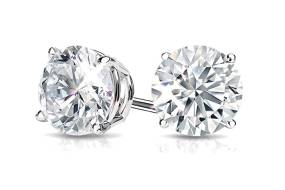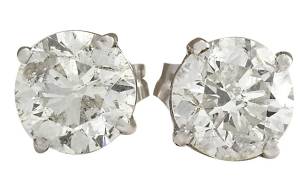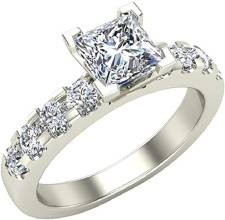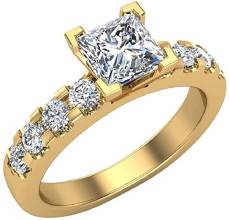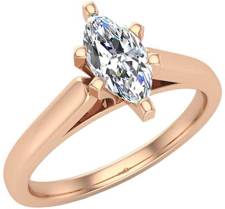As we all know, diamonds come into existence deep inside the earth. They endure extreme heat and pressure during this formation process. The ordeal impacts the gem with unique marks. These can either be internal, when they are called inclusions. External imperfections are called blemishes. VS1 Clarity Diamonds may just have a couple of very small inclusions that are invisible to the naked eye.
Click On The Images
The clarity of a diamond is a measure of its absence of inclusions & other blemishes. There are very few diamonds without these birthmarks. And such rarity makes them very valuable. The GIA Diamond Clarity Grading System grades diamonds from flawless (FL) to diamonds with eye-visible inclusions (I3).
Virtually no diamond looks perfect under 10× magnification. A select few extraordinary stones come close to such a degree of perfection. These remarkably rare gems achieve the flawless grade. Most jewelers will never see such a stone in their lifetimes.
The GIA Clarity Scale for diamonds confers eleven grades on diamonds. Vast majority of them are given VS (very slightly included) or SI (slightly included) ratings. Grading procedure takes into account various clarity traits that are visible under 10× magnification. These factors are: size of inclusion, nature of inclusion, position of inclusion, color of inclusion, etc.
Clarity Gradings are listed as follows:
Flawless (FL): A skilled grader can see no inclusions or blemishes using a 10× magnification.
Internally Flawless (IF): A skilled grader can only see blemishes but no inclusions under 10x magnification.
Very, Very Slightly Included (VVS1 and VVS2): A skilled grader can only see
inclusions under 10× magnification with a great deal of difficulty.
Very Slightly Included (VS1 and VS2): Minor inclusions that may be difficult or easy for a skilled grader to see under 10x magnification.
Slightly Included (SI1 and SI2): A skilled grader can readily notice Inclusions under 10x magnification.
Included (I1, I2, and I3): Inclusions present can be readily seen by a skilled grader under 10x magnification and may affect transparency.
Click On The Images
An Introduction to VS1 Clarity Diamonds.
We can see from the above grading scales that VS1 is among the top-ranking clarity grades. The naked eye will find it hard to spot minute imperfections in a diamond bearing this grade. Only an observation aided by a powerful magnifying loupe will be able to see the scars.
Inclusion Profile of VS1 Clarity Diamonds
We have already seen that VS1 is an abbreviation for Very Slightly Included 1. We also know that this does not mean that the diamond is flawless. It means that an untrained and unaided eye cannot see the inclusions or blemishes.
To clarify further, professionals in GIA, assigning diamond grades receive specialized training that allows them to recognize inclusions. The said training also equips them to identify and assign various clarity grades correctly. This is essential since rating diamonds consistently is a challenging task. The fact that inclusions differ from diamond to diamond complicates matters further.
So if you really want to see the foibles in a VS1 clarity diamond, get a 10x magnification jeweler’s loupe. Bring the entire stone into the focus of the eyepiece. Even then your eyes will take a few seconds to spot the imperfections.
When diamonds are growing deep inside earth, their inclusions acquire different sizes, shapes, nature, number and location. Consequently, their impact on the clarity grade is different.
Larger and more prominent imperfections diminish the clarity grade. Only infinitesimal eye-invisible inclusions can qualify stones to be VS1 Clarity Diamonds.
Location of Inclusions.
Also, the imperfections and inclusions would have to be inside the gem away from the surface. Further, they should not mar the beauty of the diamond in any way.
VS1 Clarity Diamonds are allowed a maximum of two inclusions. Furthermore, they should be located close to the girdle as they are much harder to notice in that place. On the other hand, closer they get to the center table, lower the clarity grade goes as they become easier to notice here.
Besides, inclusions closer to a diamond’s pavilions catch and reflect light bouncing from the facets. Such reflective inclusions are still more noticeable.
There are also diamonds that match all the 4Cs, including clarity. In such cases diamonds with less visible inclusions – i.e. nearer to the girdle – will be relatively more expensive.
Moreover, higher relief of inclusions make the diamond appear darker. This aspect leads to lower clarity grade. Inclusions in a VS1 diamond have minimal relief.
Diamond cut proportions, diamond shape and facet arrangement in a diamond can all camouflage inclusions to a certain extent. A skilled cutter can do this by proper planning before actual cutting. Additionally, an accomplished jeweler could use his skill to conceal them with the setting and the under-gallery.
Marquise Cut Diamond Engagement Ring for women
Click On The Image
Step Cut Diamonds and Clarity.
Certain diamond cuts can also have a sharp impact on the visibility of inclusions. Emerald cut and Asscher cut diamonds have long rectilinear and parallel facets that accentuate inclusions. This makes them much easier to spot. So, you have to select the best possible clarity grade for these cuts even if that means stretching your budget. On the other hand, strong scintillation of a round cut is adept at concealing inclusions.
Optimal light performance of best cuts also conceal inclusions. If the color of the diamond and the inclusion match closely, it makes the inclusion less visible. A dichotomy of color on the other hand will make the inclusions more visible. Inclusions in VS1 diamonds are typically colorless.
Moreover, inclusions increase visibility under certain light conditions and viewing angles. You should therefore view the diamond from different angles as well as under different lighting conditions if possible while choosing.
VS1 Clarity Diamonds Pricing.
Clarity is just one of the 4Cs of a diamond. So, a diamond cannot be evaluated solely on the criterion of clarity. The other 3Cs like cut, carat-weight and color also play vital roles in determining value.
If we choose the top grades for all 4Cs, the diamond will turn out to be pretty expensive. If we can afford it, well and good. Otherwise we have to compromise on other 3Cs.
To illustrate, let us assume the carat weight and cut attribute of a diamond to be constant. In such a scenario, a VS1 clarity and the top D color grade stone will cost you top dollars.
If you have to save money and still go for VS1 clarity, you have to sacrifice on color (since we are assuming the carat weight and cut attribute of the diamond to be constant). You might save around 1000 dollars for going to E color grade and a 1000 dollars more for going down still further to F color grade.
Similarly, diamonds of intermediate weights like 0.9 carats or 1.9 carats can cost substantially less than diamonds of complete weights like 1 carats or 2 carats.
You could save money by choosing a less expensive cut grade. But it is not advisable to do so, since cut is the most important of all diamond attributes.
All things considered, you should try to choose a diamond that appeals to your senses with a harmonious balance of all 4Cs within your budgetary constraints.
